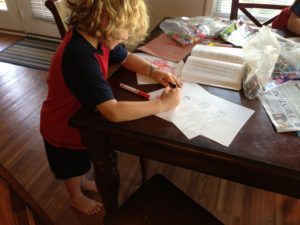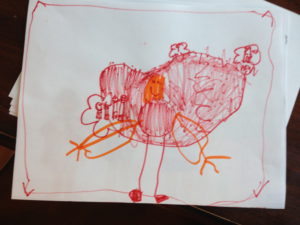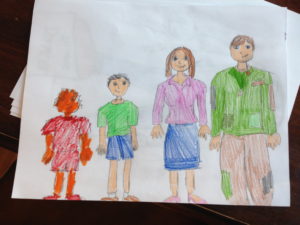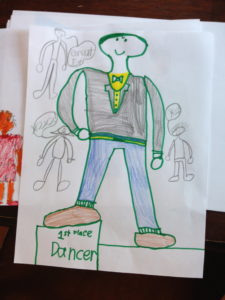Play Therapy at Home, Day 8: Drawing
I held off as long as I could before doing drawing. Drawing is one of the easiest things you can do with your child and in play therapy! Today was a day of drawing self image portraits with the option of drawing a family portrait. There is so much to be said about interpreting drawings, especially family portraits. I know you’re probably tired of me emphasizing the dangerousness of interpreting too much in your child’s play, but it’s especially important for today! If you are not aware of developmental drawing abilities for children, click here to know more (no really, you should check it out- it’s pretty cool).
 Knowing what your child is capable of drawing at their developmental level is crucial to understanding what they choose to draw, especially for these type of portraits! For example, a child around the age three to five may use stick figures to represent themselves or others (completely normal and appropriate for this age). However, if you have a child around 10 years old that mainly illustrates with stick figures it would be more concerning and could reveal possible issues of depression, low self-esteem, or even developmental delays.
Knowing what your child is capable of drawing at their developmental level is crucial to understanding what they choose to draw, especially for these type of portraits! For example, a child around the age three to five may use stick figures to represent themselves or others (completely normal and appropriate for this age). However, if you have a child around 10 years old that mainly illustrates with stick figures it would be more concerning and could reveal possible issues of depression, low self-esteem, or even developmental delays.
On the other hand, if children are drawing things that are inappropriate such as too much detail around the genitals, or heavy emphasis on those areas, this would cause concern for possible sexual abuse. If you notice any of these concerns, contact a professional to help you and do not try to interpret your child’s play or drawings on your own. There is so much that I could give you today, but I don’t want to give you too much to become dangerous.
I really want this project to be fun, so the information that I give you should be used to start conversations between you and your child, not cause you anxiety. Use the resources that I provide to ask questions and dialogue with your child instead of of you standing back and examining their work. The purpose is to open communication within your family, not to “figure them out”. Believe me, that may never happen (hehehe!).
Here are a few things to consider as you watch them draw. Don’t forget to read up on the developmental drawing stages, first!
1. Are there any body parts missing? I lack of arms could show feelings of helplessness. However, this is a developmental milestone for a child to consider drawing arms, hands, and fingers. For example, Jack forgot to draw his arms. After he was done I stated “Jackson, I noticed your picture doesn’t have any arms.” He was surprised that he forgot, so when he drew his arms, he drew them very long with strong muscles attached. This child clearly does not feel helpless or out-of-control. In fact, when I did some research, it said “control others and desires strength and power, although longer arms can also signal a desire to reach out to others.” Either way, that is definitely Jack! He also had his thoughts in thought clouds, wondering about the upcoming move. He drew a heart around all of it and colored it in saying, “Everyone will stay close to my heart.” Some of his feelings were triggered today by not having a great time in childcare during the morning (enter Mom-guilt, here.)


2. Is anything hidden? Some children may hide limbs or not to draw a part of the body because they don’t feel confident enough to draw. Geez, I even felt the pressure as I was drawing my own picture! There are some parts of the body that I am not good at drawing- So I either didn’t draw it at all, or found a way to conveniently not make room on the page for it! It’s important to realize that children may feel the same way. If there’s any hesitancy from the child to draw, they may not feel secure enough in their ability to draw it well. This provides a great opportunity to talk with them about their feelings and provide positive feedback on their effort. After our drawing time today, I looked back and realized that should not have drawn with such detail in my own picture. It would have been better to have drawn a more cartoon version of the family portrait. Too much detail could have made Jack self-conscious in his own ability to draw, or draw well.


3. Head – Did they draw their head larger than their body or much smaller than their body? Larger could be interpreted as desiring to feel smarter or better academically, whereas small could show insecurity.
4. How big is their portrait on the page? Did they take up the whole page (aggressiveness or overly confident), or make themselves tiny in the large space (Insecurity)? I’m sure you can tell by Aidan’s picture where he stands!


5. Where did they invest the most detail? This can be a conversation starter- “I noticed you spent a lot of time on ____”
6. What kind of action did they show themselves doing? This can reveal thoughts or confidence in things they are good at or what they are feeling is happening in their current relationships.
7. Lots of time erasing can show anxiety or worries of perfection.
8. What kind of smile is on the face? Obviously a smile or frown shows emotion, however if the child does not draw a mouth, it can show feelings regarding whether or not they have a voice in the home or the ability to share their thoughts and feelings.
9. Comparing the resources that I found to their drawings. I didn’t necessarily learn anything new about them but it was fun to see their drawings reflect what I thought to be true about each of their personalities.
I also wanted to share with you the emotion faces that I often use. I pulled this out as well during our drawing time and the boys had a fun time laughing at some of the silly faces. It will definitely serve them during some of our other play therapy moments.
My Feelings Activity Book (Especially great for pre-K level who are just beginning to understand emotions)
